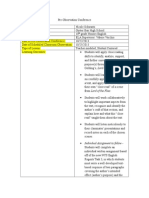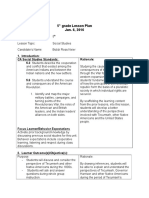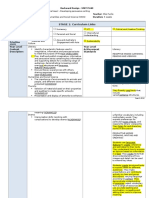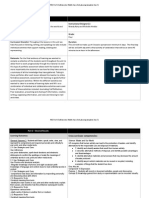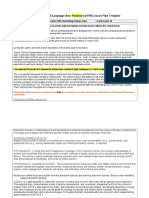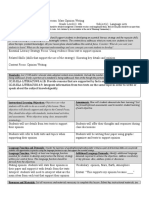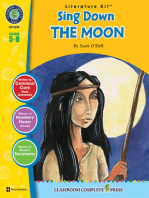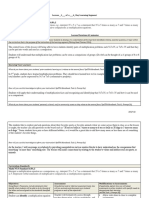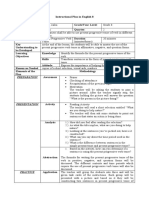Lambert@uwosh - Edu: in The Elementary School
Lambert@uwosh - Edu: in The Elementary School
Uploaded by
Lesson Study ProjectCopyright:
Available Formats
Lambert@uwosh - Edu: in The Elementary School
Lambert@uwosh - Edu: in The Elementary School
Uploaded by
Lesson Study ProjectOriginal Title
Copyright
Available Formats
Share this document
Did you find this document useful?
Is this content inappropriate?
Copyright:
Available Formats
Lambert@uwosh - Edu: in The Elementary School
Lambert@uwosh - Edu: in The Elementary School
Uploaded by
Lesson Study ProjectCopyright:
Available Formats
FINAL REPORT PART I: BACKGROUND Title: Six-Trait Writing for Content Teachers Authors: Judy C.
Lambert, Joan Simmons, Melissa Stinnett, Department of Reading Education, College of Education and Human Services University of Wisconsin Oshkosh Contact: Judy C. Lambert, lambert@uwosh.edu Discipline or Field: Reading Education, Elementary Education, Secondary Education Date: February 27, 2008 Course Name: Literacy and Language in the Content Areas, Foundations of Literacy in the Elementary School Course Description: Literacy and Language in the Content Areas is a 3 credit course designed to provide practical guidelines for those who are or will be elementary, middle school, or secondary content area teachers to assist them in using reading, writing, speaking and listening as complementary learning processes for the content area. Students of this course bring their expertise of the subject to be taught (such as English, social studies, science, mathematics, music, art, etc.), and the course assists students in dealing with the language component of the content area. Students will be given experience in producing study, pattern and concept guides, techniques for effectively presenting vocabulary, and using reading, writing, speaking and listening to facilitate learning in content areas. PK-6 and 1-8 education majors are required to take a second literacy course. They may choose this course or one of two others. Secondary education majors are required to take this course as their second literacy course. Students are usually juniors or seniors when they take this course. Class size ranges from 20-35. Foundations of Literacy in the Elementary School is a 3 credit course. Instructional strategies and materials are explored, as are various organizational patterns within the framework of balanced literacy. Word recognition, fluency and comprehension are major components. Phonics and decoding strategies along with meaning processing strategies are included with the focus on helping young readers become strategic and metacognitive. Literacy is viewed as a developmental process with promoting childrens love of reading and time spent reading as crucial elements. All PK6 and 1-8 education majors are required to take this course. Students are usually juniors when they take this course and class size ranges from 25-35.
Executive Summary: 250-450 words The goal of this project was to develop a self-contained lesson on six-trait writing specifically appropriate for content area teachers. It was intended to be a lesson that could fit into several literacy courses. In the developed lesson for Literacy and Language in the Content Areas and Foundations of Literacy in the Elementary School, undergraduate students participated in specific activities to generate new learning regarding the teaching and assessment of writing using 6-trait analysis. Learning goals for the students were: 1) to learn and understand the components of 6-trait writing; 2) to learn how to evaluate writing using a trait rubric; 3) to understand how writing can support the teaching and learning of content material; 4) to understand and appreciate 6-trait writing from the view point of the language arts teacher and the content area teacher; 5) to experience and understand pair/share, list-group-label and cloze as instructional techniques; 6) to self-assess learning; Students participated in an activity to activate and share their prior knowledge about writing in general. A mini-lesson followed regarding 6-trait writing and using rubrics for trait assessment. Students were provided practice in analyzing and evaluating a piece of writing using a specific 6-trait rubric. Throughout the lesson students participated in activities such as pair/share, list-group-label and cloze as examples of instructional techniques to use in their future classrooms. The different activities as well as the interactional design of the lesson were an attempt to facilitate learning and the application of developing skills. PART II: THE LESSON How to Teach the Lesson: This particular lesson was one hour in length and fell under the larger topic of writing instruction and assessment within a balanced literacy environment. Before the Lesson. At the beginning of the course, students were told about the study and asked to sign consent forms (informational-permission letter.doc). Just before the lesson, students were asked to complete an anticipation guide regarding their knowledge and beliefs about 6-trait writing (anticipation guide.doc). Replicated Lesson 9:30-9:35 Activate Prior Knowledge Activity Pair/Share Activity Students are asked to reflect upon elementary school/middle school/ high school and what they learned or were taught about: 1) What is good writing?
9:35-9:50
2) What kinds of writing activities do you remember participating in? 3) How did you feel about writing? Students turn to a neighbor and share their reflections.
Instructor briefly goes over the stages of the writing process, such as prewriting, writing, post-writing, and students are asked the difference between revision and editing (writing process overhead.doc). List-Group-Label Activity Students as a whole group brainstorm what makes good writing. Instructor records student-volunteered information on prepared 6-trait overhead. Instructor places student generated characteristics in six different boxes and students label the boxes (what makes good writing.doc).
9:50-10:05 Mini-Lesson Students are provided a handout on 6+1-trait writing (definition of traits.doc). Students read and compare with what was generated on overhead. Instructor provides a mini-lecture to clear up any misunderstandings and specifically clarifies the additional aspect of presentation as the +1 trait.
10:05-10:25
Cooperative Group Activity (writing sample-statues.doc, writing samplesuccessful.doc, scoring rubric.pdf) Students are randomly arranged in small groups. Each group is provided with two writing samples (one well written and one not so well written) and a 6-trait rubric to use for scoring each sample. The two writing samples are also taped to the wall. Each student has a scoring rubric, plus the group has one for them to summarize on. After students in each group score each sample, they place their group rubric on the wall under the appropriate sample. Students compare the way each group scored each sample. How much did they agree or disagree? Why the discrepancies? A teacher-lead discussion of the differing view points leads into a minidiscussion on the use of the rubric and also of the difference between the role of language arts teachers and content area teachers in the use of 6-trait writing.
10:25-10:30
Cloze Activity (cloze-6-trait.doc) To help them self-assess their own learning, students are given a cloze activity to complete. It also reinforces their understanding of 6-trait writing and the content area teachers perspective.
Instructor and students go over the cloze activity and any misunderstandings are discussed.
After the Lesson. At the next class session, students are asked to evaluate the previous days lesson (student-observer-instructor eval.doc). After one week, students are asked to redo the anticipation guide (anticipation guide.doc). Differences between this lesson and lesson as originally planned: 1) It was replicated in Reading 305, Foundations of Literacy in the Elementary School, instead of Reading 440, Literacy and Language in the Content Areas. 2) Dr. Melissa Stinnett taught the lesson instead of Dr. Joan Simmons. 3) Minor stylistic changes naturally took place during the replication due to the different instructor and the dynamics of the class. 4) The replicated lesson involved primarily elementary education students, rather than a mixture also including middle and secondary education students. 5) Students were grouped differently. In the original lesson they were placed into content area groups, in the replicated lesson they were grouped randomly. 6) Students in the original lesson, were asked in their content area groups, which trait they felt was most important for the content area. In the replicated lesson, students were asked on the lesson evaluation form to indicate which trait they felt was most important. 7) A mini-lecture was presented on 6+1-trait writing in the replicated lesson. 8) In the original lesson, each group of students evaluated only one writing sample. In the replicated lesson, all groups of students evaluated both writing samples. 9) In the replicated lesson, each student was given their own rubric to use for evaluating each sample and an additional one was provided for the group as a whole to use. 10) Simmons and Lambert were observers rather than Stinnett and Lambert. Student Learning Goals: 1) 2) 3) material; 4) to learn and understand the components of 6-trait writing; to learn how to evaluate writing using a trait rubric; to understand how writing can support the teaching and learning of content
to understand and appreciate 6-trait writing from the view point of the language arts teacher and the content area teacher; 5) to experience and understand pair/share, list-group-label and cloze as instructional techniques; 6) to self-assess learning;
Rationale: 1) Typically students in these two specific courses have a wide range of prior knowledge relating to the topic of 6-trait writing. Some have none, some a little, and occasionally a student has been specifically trained in 6-trait writing assessment. 2) Even if students are aware of 6-trait writing, it is usually only from the perspective of the language arts teacher. Students are not aware of how content teachers can support six-trait writing in their subject area and also how writing can be used to help students learn and understand content area information. 3) Students, particularly those preparing to be art, music, math, or physical education teachers, are often very resistant to believing that writing can be a way to enhance content in their particular subject areas. PART III: THE STUDY Approach: Data collection involved three forms of evidence: 1. Student, observer and instructor evaluations of the lesson (student-observerinstructor eval.doc). This was done for both the original and replicated lesson. 2. Observations of lessons. Two members of the lesson study team recorded field notes during each lesson. Suggestions from the observers from the first lesson led to most of the changes made in the replicated lesson. 3. Student work samples. These included: 1) anticipation guide completed pre and post lesson (anticipation guide.doc); 2) student listing of traits as most important; 3) student scoring of writing samples. Findings: Evaluation Data This consisted of student, observer and instructor evaluations of the original and replicated lesson. Rating scale descriptors: 4---strongly agree; 3---agree; 2---disagree; 1--strongly disagree. Higher values are more positive in all cases except for percentage listing for least favorite activity.
Table 1 Student Evaluation of Lessons Original Replicated n=30 n=31 3.5 3.4 3.5 3.5 3.2 3.0 3.4 3.1 3.6 3.8 FAV./L.FAV FAV./L.FAV 0% 24% 17% 16% 3% 41% 0% 52% 83% 10% 77% 3% 14% 21% 6% 29% 3%
Lesson was well organized Activities helped explain lesson content Learned a lot about 6 +1 Trait writing Lesson was interesting 6+1-trait writing important for content teachers LESSON ACTIVITIES Pair-Share Activity List-Group-Label Activity Scoring Exercise with Rubrics Cloze Activity None
Table 2 Observer Evaluation of Lesson Original Replicated n=2 n=2 4.0 4.0 3.5 4.0 3.0 3.0 4.0 4.0 3.5 4.0 FAV./L.FAV FAV./L.FAV 0% 0% 0% 50% 50% 0% 0% 0% 0% 100% 50% 50% 50% 0% 50% 0%
Lesson was well organized Activities helped explain lesson content Learned a lot about 6 +1 Trait writing Lesson was interesting 6+1-trait writing important for content teachers LESSON ACTIVITIES Pair-Share Activity List-Group-Label Activity Scoring Exercise with Rubrics Cloze Activity
Table 3 Instructor Evaluation of Lesson Original Replicated n=1 n=1 4.0 4.0 4.0 4.0 3.0 4.0 4.0 4.0 4.0 3.0 FAV./L.FAV FAV./L.FAV 0% 0% 100% 0% 0% 0% 0% 0% 100% 0% 0% 100% 0% 0% 0% 0%
Lesson was well organized Activities helped explain lesson content Learned a lot about 6 +1 Trait writing Lesson was interesting 6+1-trait writing important for content teachers LESSON ACTIVITIES Brainstorming/Pair-Share Activity List-Group-Label Activity Scoring Exercise with Rubrics Cloze Activity Observation Data
Both of the other two lesson study participants observed each lesson. Based on the field notes taken by each observer, items 7-9 listed in the differences between the replicated lesson and lesson as originally planned were developed. Student Work Data Student work involved the pre and post anticipation guide, the rating of the traits, and the rating of the writing samples. The rating scale for the anticipation guide was true---4, false---0; 4---have used it; 3---understand it well; 2---know a little about it; 1--only heard of it; and 4---strongly agree; 3---agree; 2---disagree; 1---strongly disagree. In all cases higher numbers are more positive except for Writing is most important for Language Arts.
Table 4 Student Pre and Post Lesson Anticipation Guide Original n=30 Pre Post Heard of 6 Trait Writing Know what 6 trait involves Know the 6 traits Writing is most important in Language Arts Know what process writing is Knowledge Rating Voice Sentence Fluency Ideas Organization Conventions Presentation Writing is important in the content areas 6-trait writing can be used in the content areas 6-trait writing should be used in the content areas 3.6 3.5 3.6 0.7 3.9 3.4 3.5 3.5 3.6 3.2 3.5 3.7 3.6 3.6 4.0 4.0 4.0 0.9 4.0 4.0 4.0 4.0 4.0 4.0 4.0 3.6 3.6 3.5 Replicated n=31 Pre Post 4.0 3.9 3.7 1.7 3.7 3.6 3.6 3.9 3.7 3.5 3.6 3.8 3.8 3.7 4.0 4.0 3.9 1.6 4.0 3.8 3.8 3.9 3.8 3.8 3.9 3.8 3.9 3.8
Table 5 Student Choice of Which Trait is Most Important Original Rank 2 30% 1 35% 4 10% 6 5% 3 15% 7 0% 5 10% Replicated Rank 1 41% 3 19% 2 26% 4 8% 5 3% 5 3% 7 0%
Which Trait is most Important Ideas Organization Voice Sentence Fluency Word Choice Conventions Presentation
Table 6 Observer and Instructor Choice for Most Important Trait Which Trait is most Important Original Observers n=2 0% 50% 0% 50% 0% 0% Instructor n=1 0% 100% 0% 0% 0% 0% Replicated Observers n=2 0% 50% 0% 50% 0% 0% Instructor n=1 0% 100% 0% 0% 0% 0%
Voice Ideas Organization Sentence Fluency Convention Word Choice Which Trait is most Important Voice Ideas Organization Sentence Fluency Convention Word Choice
Table 7 Content Area Students Choice for Most Important Trait for their Content Area Ideas Organization Voice Sentence Fluency Word Choice Conventions Presentation
Science Social Studies Math Language Arts
Science Social Studies Math
Language Language Math Arts Arts Social Social Studies Studies Science
Math
Table 8 Scoring of Writing Samples Original Lesson Sample 1 Ideas Organization Voice Word Choice Fluency Conventions Sample 2 Ideas Organization Voice Word Choice Fluency Conventions Replicated Lesson Sample 1 Ideas Organization Voice Word Choice Fluency Conventions Sample 2 Ideas Organization Voice Word Choice Fluency Conventions
Statutes (Simplistic) Minimal Basic Proficient 0% 66% 33% 0% 66% 33% 0% 100% 0% 0% 33% 66% 0% 66% 33% 0% 0% 66% Successful (Advanced) Minimal Basic Proficient 0% 33% 66% 0% 33% 66% 0% 66% 33% 0% 0% 100% 0% 66% 33% 0% 33% 66%
Advanced 0% 0% 0% 0% 0% 33% Advanced 0% 0% 0% 0% 0% 0%
Statutes (Simplistic) Minimal Basic Proficient 0% 40% 40% 0% 20% 80% 40% 40% 20% 20% 20% 60% 0% 100% 0% 0% 20% 60% Successful (Advanced) Minimal Basic Proficient 0% 40% 60% 0% 40% 40% 0% 20% 60% 0% 0% 60% 0% 20% 80% 0% 20% 60%
Advanced 20% 0% 0% 0% 0% 20% Advanced 0% 20% 20% 40% 0% 20%
Discussion: Evaluation Data (Tables 1, 2, & 3) In general there was more variability in student responses than in instructor responses. This can be attributed to there being many more students (30 and 31) than instructors (2). The instructors obviously rated the lesson high because they had planned and implemented the lesson in what they thought was the best way possible. The observers tended to agree, with there being only some minor variability. Students, in general, rated the lesson components positively with scores for the first lesson ranging from a high of 3.6 for 6-trait being important for content teachers to a low of 3.2 for learning a lot about 6-trait writing. In the second lesson, there was a high of 3.8 for students seeing 6-trait as being important for content teachers and a low of 3.0 for learning a lot about 6-trait writing. The aspect of learning a lot about 6-trait writing was the lesson element evaluated lowest by students in both lessons. A couple of students indicated in their comments that the lesson was primarily review of previous learning for them. When comparing the replicated lesson to the original lesson, there was only one aspect that had more than 2/10s of a point in difference. That was in was the lesson interesting. Students rated the lesson as interesting 3.4 in the original lesson, but only 3.1 in the replicated lesson. We feel that this may be attributable to the fact that it was determined by the observers after the first lesson that students needed to be provided with more information about 6-trait writing in the form of a mini-lecture. Thus, rather than being involved in small group activities throughout the replicated lesson, students were provided a traditional lecture, and perhaps they felt this caused the lesson to be less interesting. Students in both lessons, indicated that their favorite part of the lesson was the scoring exercise with the rubric, 83% in the original lesson and 77% in the replicated lesson. The list-group-label activity was the least favorite, receiving 3% in the original and 0% in the replicated lesson as the favorite activity, and 41% and 52% as their least favorite activity. The observers tended to strongly disagree here thinking that the scoring activity was the least effective activity in the original lesson and that the list-grouplabel and cloze activities were the most effective. In the replicated lesson, with the changes that were done, (each group of students scoring both writing samples) they felt that the scoring activity and the cloze were the most effective. These differences perhaps can be attributed to the way students and observers viewed the term favorite. Observers were rating effectiveness whereas students perhaps rated an activity high because they liked it or thought it was fun. Rather than asking for favorite activity we should have asked which was most valuable or effective for learning. It did seem that favorite activities for observers were more teacher-controlled activities while students chose the more active group activities as their favorites. Student Work Data (Tables 4, 5, 6, 7, and 8) Pre and post lesson data from the anticipation guide is found in table 4. In the original lesson, all scores went up, as would be expected, except for the two more
affective statements of writing is important in the content areas and 6-trait writing should be used in the content areas. These actually, went down one tenth of a point each. This was not deemed upsetting as the pre-scores on these two measures were high to begin with, 3.7 and 3.6 respectively. The biggest change in the original lesson on the post-anticipation guide was in knowledge of conventions, moving from 3.2 to 4.0. This is extremely interesting because both instructors and all observers felt that students really knew the most about the trait of conventions. It is thought that perhaps the students in the pre-data were just not applying the label of conventions to what they know about correct spelling, punctuation, grammar, etc. It is interesting to note, that in the original lesson on the post test data, all scores for the 6-traits were 4.0 indicating that they have used that particular trait. This is good as they actually had used them in the class. The scores here though, for the students in the replicated lesson, on each trait only approached 4.0, ranging from 3.8-3.9, perhaps indicating that the students in this group were not as confident in their usage of these traits. This could be a result of the first group scoring only one sample while in the replicated lesson, two samples were scored thus providing double the practice. In the replicated lesson they were also able to compare a strong and a weaker writing sample. In the replicated lesson every element stayed the same or went up except for writing is most important in language arts. This is positive because it was a misconception that we were hoping to change. Table 5 contains data regarding which trait students think is most important. It should be noted that students in the content area reading class, were specifically asked Which is most important, do you think, for your specific content area? As the other students, were primarily elementary education majors, they were just asked Which trait to you think is most important? Ideas and organization were in the top three choices for students from both lessons and conventions was in the bottom two choices. It is interesting to note that when looking at how the traits ranked, no specific trait varied by more than a two rank difference between the two groups. Table 6 contains the information from the observers and the instructors. They differed from the students, agreeing that organization was important, but also indicating that sentence fluency was very important. It is positive to note that both instructors agreed with students and rated ideas as the most important. It is also acknowledged by the observers and instructors that they really just picked a trait, because at different times and depending on the assignment or activity different traits would become more or less important. The original lesson had the students in content area groups and the rating was specifically for their content area. Table 7 specifically contains this information. Students in the language arts groups chose fluency, voice and ideas as being most important. Math groups selected word choice organization, presentation and ideas. Social Studies groups chose word choice, voice organization and ideas, and science groups chose word choice, organization and ideas. It is interesting to note, that no group chose conventions and students in a math group were the only ones to choose presentation. It was not surprising that there was this much disagreement among students in the same content area. This led to positive class interaction as students
provided their reasoning and defended their trait selections. It was the intention of the instructors also that students understand that traits at different times can vary in importance. Table 8 contains the scoring data from the writing samples. In the original study, half of the class in small groups scored one student sample using the defined criteria in the rubric while the other half of the class, also in small groups, scored the second sample. Sample 1 labeled Statues was written in a very simplistic fashion with basic vocabulary while Sample 2 labeled Successful was written in a more sophisticated fashion with complex vocabulary and ideas. In the original lesson students only read one sample, and the groups reading Sample 1 Statues felt that they had over estimated the proficiency of the student after hearing the second sample and seeing how the other groups had evaluated it. Were they to do the exercise again, they would want both samples for comparison. Since they were all secondary content students, they had not had a great deal of practice evaluating writing with a rubric and especially not using the six traits. Students in the replicated study were given both samples to score. Thus in the replicated lesson, students consistently rated Successful more highly than Statues. In both lessons, students varied a lot in their scoring of many of the traits for both samples. This led to a discussion of the subjectivity of evaluating the traits and how important it is to have a well defined evaluation rubric. Recommended Further Lesson Revisions If we were to gather evaluation data again for this lesson, we would ask students to rate the amount of distraction they perceived from the video taping and having the observers present in the classroom. We would also ask students, observers and instructors to evaluate the specific learning objectives identified for the lesson. Also, rather than asking their favorite activity, we would ask which activity they thought most effective or valuable for learning. In terms of lesson refinement, we would try to make activities more differentiated for students who have had prior exposure to 6-trait writing. Next steps may also involve documenting how students in the Content Area Reading class use writing in their content area teaching units.
References: Belamy. P. (2004). Picture books: an annotated bibliography with activities for teaching writing with the 6+1 Trait writing model. Portland, OR: NWREL. Culham, R. (2003). 6+1 traits of writing: the complete guide, grades 3 and up. New York: Scholastic. Culham, R, & Wheeler, A. (2003). Writing to prompts in the trait-based classroom: Literature response (grades 3 and up). New York: Scholastic. Culham, R, & Wheeler, A. (2003). Writing to prompts in the trait-based classroom: content areas (grades 3 and up). New York: Scholastic.
Culham, R. (2005). 6+1 traits of writing: the complete guide for the primary grades. New York: Scholastic. Sloan, M. (2005). Trait-based mini-lessons for teaching writing in grades 2-4. New York: Scholastic. Spandel, V., & Culham, R. (2007). Student-friendly guide to writing with traits. Portland, OR: NWREL. Stepanek, J., Appel, G., Leong, M., Mangan, M., & Mitchell. (2007) Leading lesson study: a practical guide for teachers and facilitators. Thousand Oaks, CA: Corwin Press.
APPENDIX I. Instructional Materials 1) Instructional Overheads writing process over head.doc what makes good writing.doc 2) Class Handouts definition of traits.doc writing sample-statues.doc writing sample-successful.doc scoring rubric.pdf cloze-6 trait.doc 3) Miscellaneous masking tape
II. Materials to Study Lesson 1) Evaluation Forms anticipation guide.doc student-observer-instructor eval.doc
III. Other 1) informational-permission letter.doc
You might also like
- CTET Success Master Maths & Science (Class 6-8)Document719 pagesCTET Success Master Maths & Science (Class 6-8)tirumala100% (3)
- Backward DesignDocument6 pagesBackward Designapi-335302164No ratings yet
- Unit Sample The Hunger GamesDocument23 pagesUnit Sample The Hunger Gamesapi-248040483No ratings yet
- Teaching Reading and WritingDocument10 pagesTeaching Reading and WritingImelda Arreglo-Agripa100% (1)
- Portfolio Pre-Observation Close ReadDocument6 pagesPortfolio Pre-Observation Close Readapi-279291777No ratings yet
- A Teaching Methodology (Supplimentary Docs.)Document73 pagesA Teaching Methodology (Supplimentary Docs.)Vireak Som0% (1)
- Linguistic ImperialismDocument46 pagesLinguistic ImperialismmichieleoNo ratings yet
- Classroom Assessment For Learning ChappuisDocument5 pagesClassroom Assessment For Learning ChappuisRothinam NirmalaNo ratings yet
- LET Review Assessment of LearningDocument150 pagesLET Review Assessment of LearningAngelo Aniag Unay96% (27)
- Otl565 Module 6Document10 pagesOtl565 Module 6api-250173714No ratings yet
- AP 11 Syllabus Final DraftDocument19 pagesAP 11 Syllabus Final DraftAnonymous Azxx3Kp9No ratings yet
- Lesson Plan Template PenfriendsDocument7 pagesLesson Plan Template Penfriendsapi-381368479No ratings yet
- EPE510 Assignemt 1 S224573 Roy SmithDocument11 pagesEPE510 Assignemt 1 S224573 Roy SmithRoy SmithNo ratings yet
- "4 Styles of Writing": Grade 9 English Language Arts Miss. Denyer Duration: October 31 - November 25Document9 pages"4 Styles of Writing": Grade 9 English Language Arts Miss. Denyer Duration: October 31 - November 25api-299681637No ratings yet
- Studentteaching Ela Edtpa LessonplanDocument8 pagesStudentteaching Ela Edtpa Lessonplanapi-301667326No ratings yet
- Week 8 Process Writing Lesson Plan FinalDocument3 pagesWeek 8 Process Writing Lesson Plan Finalapi-543433779No ratings yet
- UMF Unit-Wide Lesson Plan TemplateDocument4 pagesUMF Unit-Wide Lesson Plan Templateapi-534288634No ratings yet
- Unit OverviewDocument3 pagesUnit Overviewapi-265568186No ratings yet
- 5 Grade Lesson Plan Jan. 6, 2016: CA Social Studies Standards: 5.3 Students Describe The Cooperation RationaleDocument5 pages5 Grade Lesson Plan Jan. 6, 2016: CA Social Studies Standards: 5.3 Students Describe The Cooperation Rationaleapi-305432838No ratings yet
- Secondary English Language Arts: Revised ed:TPA Lesson Plan TemplateDocument9 pagesSecondary English Language Arts: Revised ed:TPA Lesson Plan Templateapi-341978939No ratings yet
- Teaching WritingDocument63 pagesTeaching Writing063อชิระ นพดลไชย100% (1)
- Unit Plan Non FictioneditedDocument8 pagesUnit Plan Non Fictioneditedapi-311702790No ratings yet
- Textbook EvaluationDocument10 pagesTextbook EvaluationMerbai MajdaNo ratings yet
- Fall 2024 EDRD A421 and A525 Assessments in Reading SyllabusDocument10 pagesFall 2024 EDRD A421 and A525 Assessments in Reading SyllabuscalayahhhNo ratings yet
- Writingplan Persuasivetexts 2020Document3 pagesWritingplan Persuasivetexts 2020api-424238197No ratings yet
- Content Sequencing Meaning and ImportanceDocument4 pagesContent Sequencing Meaning and ImportanceAttong Bryan AmpangNo ratings yet
- Curriculumtools Curriculummap-Grade4 072017Document14 pagesCurriculumtools Curriculummap-Grade4 072017manalonelliejoysNo ratings yet
- Task 3Document18 pagesTask 3api-334082022No ratings yet
- Sample Lesson PlanDocument10 pagesSample Lesson Planapi-356344648No ratings yet
- Professional Experience 4 SP5 2018: Teacher As InquirerDocument23 pagesProfessional Experience 4 SP5 2018: Teacher As Inquirerapi-361854774No ratings yet
- SiopDocument45 pagesSiopapi-654549655No ratings yet
- Lesson Plan (Small Group)Document5 pagesLesson Plan (Small Group)api-294827057No ratings yet
- W 9-10 Objectives For Reading and ListeningDocument7 pagesW 9-10 Objectives For Reading and ListeningJuan AlvarezNo ratings yet
- Reading Writing and Speaking StrategiesDocument31 pagesReading Writing and Speaking Strategiesapi-295579696100% (1)
- Content Standard(s) Addressed by This Lesson:: STEPP Lesson Plan FormDocument6 pagesContent Standard(s) Addressed by This Lesson:: STEPP Lesson Plan Formapi-282071507No ratings yet
- Lambert@uwosh - Edu: AreasDocument11 pagesLambert@uwosh - Edu: AreasLesson Study ProjectNo ratings yet
- College 3 Online Course IntroductoryDocument16 pagesCollege 3 Online Course IntroductoryMisheel BoldNo ratings yet
- Persuasive Writing: Final Project - Individual WorksheetDocument5 pagesPersuasive Writing: Final Project - Individual Worksheetapi-314247862No ratings yet
- Lorax Unitplan TemplateDocument15 pagesLorax Unitplan Templateapi-277312665No ratings yet
- Equipping All Students For Success in STEMDocument5 pagesEquipping All Students For Success in STEMCesar Angeles LunaNo ratings yet
- EDRL443-WritingCenter NatalyAbrego.Document2 pagesEDRL443-WritingCenter NatalyAbrego.Miss_AbregoNo ratings yet
- MothertongueDocument36 pagesMothertonguenicolemolina133No ratings yet
- Cal Unit PlanDocument6 pagesCal Unit Planapi-278816373No ratings yet
- Edu80016 - Assess-Curriculum LinkDocument7 pagesEdu80016 - Assess-Curriculum LinkSalima Abdallah ObeidNo ratings yet
- Teaching Writing Through Genre AnalysisDocument8 pagesTeaching Writing Through Genre AnalysisLiyana MokhtarNo ratings yet
- Teaching MaterialsDocument3 pagesTeaching MaterialsraziyemileyNo ratings yet
- Edu 512 All Tompkins QuestionsDocument24 pagesEdu 512 All Tompkins Questionsapi-365492493No ratings yet
- Sarah King Lesson Plan W4Document4 pagesSarah King Lesson Plan W4Sarah KingNo ratings yet
- Ci 403 Unit Plan Lesson 2 1Document10 pagesCi 403 Unit Plan Lesson 2 1api-302766620No ratings yet
- Baikd Part eDocument5 pagesBaikd Part eapi-317153463No ratings yet
- Second Lesson OpinionDocument5 pagesSecond Lesson Opinionapi-450830120No ratings yet
- Year 7 teacher support resourceDocument12 pagesYear 7 teacher support resourcestgregNo ratings yet
- Lesson Plan Recognizing AudienceDocument21 pagesLesson Plan Recognizing AudienceCPaulE33No ratings yet
- Pages From Introduction To Genre Based Approach Part 3Document14 pagesPages From Introduction To Genre Based Approach Part 3veeaNo ratings yet
- Redmond Te848 Curriculum Analysis ProjectDocument20 pagesRedmond Te848 Curriculum Analysis Projectapi-299535931No ratings yet
- Part B Lesson Plans For Learning SegmentDocument16 pagesPart B Lesson Plans For Learning Segmentapi-712062930No ratings yet
- Seminar On Teaching English As A Foreign Language Summary: Text-Based ApproachDocument4 pagesSeminar On Teaching English As A Foreign Language Summary: Text-Based ApproachRudyNo ratings yet
- C Bsu-101Document3 pagesC Bsu-101Shanzy ChaudharyNo ratings yet
- Romeo Juliet UnitDocument5 pagesRomeo Juliet UnitdressageisworldNo ratings yet
- Secondary English Language Arts: Revised ed:TPA Lesson Plan TemplateDocument10 pagesSecondary English Language Arts: Revised ed:TPA Lesson Plan Templateapi-341978939No ratings yet
- M1 L2 PRDocument5 pagesM1 L2 PRDaniela GuetaNo ratings yet
- FP007-CM-Eng - Trabajo JHON ORTIZDocument10 pagesFP007-CM-Eng - Trabajo JHON ORTIZJhon Ortiz100% (1)
- Literacy:: Lines of InquiryDocument2 pagesLiteracy:: Lines of InquiryteacherensNo ratings yet
- Common Core Snapshot: Administrator's Guide to the Common CoreFrom EverandCommon Core Snapshot: Administrator's Guide to the Common CoreNo ratings yet
- Galbrait - Anne@uwlax - Edu: Lesson Study Final Report (Short Form) Title: Team MembersDocument5 pagesGalbrait - Anne@uwlax - Edu: Lesson Study Final Report (Short Form) Title: Team MembersLesson Study ProjectNo ratings yet
- Part I: Background: Lesson Study: Developing Students' Thought Processes For Choosing Appropriate Statistical MethodsDocument14 pagesPart I: Background: Lesson Study: Developing Students' Thought Processes For Choosing Appropriate Statistical MethodsLesson Study ProjectNo ratings yet
- Lesson Study Final Report Template: RD TH THDocument6 pagesLesson Study Final Report Template: RD TH THLesson Study ProjectNo ratings yet
- Lesson Study Project Showcase Catl@uwlax - EduDocument10 pagesLesson Study Project Showcase Catl@uwlax - EduLesson Study ProjectNo ratings yet
- Final Lesson Study Guidelines: Part I: BackgroundDocument11 pagesFinal Lesson Study Guidelines: Part I: BackgroundLesson Study ProjectNo ratings yet
- Mweege@uwlax - Edu Astaffaroni@uwlax - EduDocument13 pagesMweege@uwlax - Edu Astaffaroni@uwlax - EduLesson Study ProjectNo ratings yet
- Wardj@uwp - Edu: Learning Goals: Students Will Gain A Deeper Understanding of Water Resource Issues, The Importance ofDocument5 pagesWardj@uwp - Edu: Learning Goals: Students Will Gain A Deeper Understanding of Water Resource Issues, The Importance ofLesson Study ProjectNo ratings yet
- Part I: Background TitleDocument13 pagesPart I: Background TitleLesson Study ProjectNo ratings yet
- Lesson Study Final Report TemplateDocument6 pagesLesson Study Final Report TemplateLesson Study ProjectNo ratings yet
- Lesson Study Final Report Part I: Background Lesson TopicDocument9 pagesLesson Study Final Report Part I: Background Lesson TopicLesson Study ProjectNo ratings yet
- UntitledDocument27 pagesUntitledLesson Study ProjectNo ratings yet
- TITLE: GESTURE DRAWING: The Essence of Capturing The Moment As A Tool For Extended InvestigationDocument10 pagesTITLE: GESTURE DRAWING: The Essence of Capturing The Moment As A Tool For Extended InvestigationLesson Study ProjectNo ratings yet
- UntitledDocument20 pagesUntitledLesson Study ProjectNo ratings yet
- Establishing Trigonometric Identities: THE STUDY ApproachDocument2 pagesEstablishing Trigonometric Identities: THE STUDY ApproachLesson Study ProjectNo ratings yet
- Interdisciplinary Lesson Study: Communication Studies and Library Information Literacy ProgramDocument12 pagesInterdisciplinary Lesson Study: Communication Studies and Library Information Literacy ProgramLesson Study ProjectNo ratings yet
- UntitledDocument4 pagesUntitledLesson Study ProjectNo ratings yet
- Lesson Study Final Report: Part I: Background Title: AuthorsDocument28 pagesLesson Study Final Report: Part I: Background Title: AuthorsLesson Study ProjectNo ratings yet
- UntitledDocument19 pagesUntitledLesson Study ProjectNo ratings yet
- UntitledDocument21 pagesUntitledLesson Study ProjectNo ratings yet
- Horibe@physics - Wisc.edu Bjunderwood@wisc - EduDocument25 pagesHoribe@physics - Wisc.edu Bjunderwood@wisc - EduLesson Study ProjectNo ratings yet
- Establishing Trigonometric Identities: THE LESSON How To Teach The LessonDocument3 pagesEstablishing Trigonometric Identities: THE LESSON How To Teach The LessonLesson Study ProjectNo ratings yet
- Lambert@uwosh - Edu: AreasDocument11 pagesLambert@uwosh - Edu: AreasLesson Study ProjectNo ratings yet
- UntitledDocument35 pagesUntitledLesson Study ProjectNo ratings yet
- BSBWOR502 - JinishaDocument34 pagesBSBWOR502 - JinisharoopaNo ratings yet
- Lesson Plan 1 11111Document11 pagesLesson Plan 1 11111api-402693640No ratings yet
- 4245 Eberlin Jason Vero Eraldo Assig3Document9 pages4245 Eberlin Jason Vero Eraldo Assig3api-348718668No ratings yet
- American Indian Tribes: 3rd GradeDocument72 pagesAmerican Indian Tribes: 3rd Gradeapi-349474344No ratings yet
- ACS DRA2 GuidelinesDocument6 pagesACS DRA2 GuidelinesJen MunnerlynNo ratings yet
- Managing School-Based Assessment: Challenges and Solutions For Educational PracticeDocument23 pagesManaging School-Based Assessment: Challenges and Solutions For Educational PracticerNo ratings yet
- Performance Assessment in Classroom - GardenDocument18 pagesPerformance Assessment in Classroom - Gardenapi-113553268100% (1)
- Week 15 Activity SheetDocument3 pagesWeek 15 Activity SheetFrancel bicbicNo ratings yet
- ACCT601 Australian Auditing and Assurance Services 201660Document15 pagesACCT601 Australian Auditing and Assurance Services 201660Rafayel MarufNo ratings yet
- Materi Valerie WilsonDocument27 pagesMateri Valerie WilsonAzusaTachibanaNo ratings yet
- Lesson Log-Sample For Blended LearningDocument3 pagesLesson Log-Sample For Blended LearningHanzel PoldoNo ratings yet
- Midw335 Babies Needing Extra Care.Document9 pagesMidw335 Babies Needing Extra Care.Kirsty MarshallNo ratings yet
- 4 2020 Special Education Evaluation Practices and Procedures ImplicationsDocument9 pages4 2020 Special Education Evaluation Practices and Procedures ImplicationsCzarinaNo ratings yet
- AQTF LearnerQuestionnaireLQ 005Document2 pagesAQTF LearnerQuestionnaireLQ 005eric3862No ratings yet
- IPlan Present ContinuousDocument2 pagesIPlan Present ContinuousJai-jaiNo ratings yet
- PED 103 AND 104 ReviewerDocument32 pagesPED 103 AND 104 ReviewerAliya Jimenez100% (1)
- HUMSS - Disciplines and Ideas in The Applied Social Sciences CG - 1Document8 pagesHUMSS - Disciplines and Ideas in The Applied Social Sciences CG - 1Mello Jane Garcia DedosinNo ratings yet
- Hiring Guidelines For Teacher I Positions Effective School Year (Sy)Document25 pagesHiring Guidelines For Teacher I Positions Effective School Year (Sy)Aladin CabanigNo ratings yet
- of Group 6 in Assessment in Learning 1Document23 pagesof Group 6 in Assessment in Learning 1Angelica CerbitoNo ratings yet
- Vijaya Bhanu Kote : Training Transcript Educator CenterDocument33 pagesVijaya Bhanu Kote : Training Transcript Educator CenterVijayaBhanuKoteNo ratings yet
- Somaliland QA Framework For Higher Education 2024Document46 pagesSomaliland QA Framework For Higher Education 2024Musyoki MusyokaNo ratings yet
- TR - Tailoring (Casual) NC IIDocument58 pagesTR - Tailoring (Casual) NC IIJMiguel Abueg100% (4)
- BSN 1st Sem 27 Jan 22Document52 pagesBSN 1st Sem 27 Jan 22Muhammad FareedNo ratings yet
- City of Seattle - SDOT 2015 Asset Management ReportDocument121 pagesCity of Seattle - SDOT 2015 Asset Management ReportThe UrbanistNo ratings yet
- Formative Assessment Is Conducted To Assess or Monitor The LearnersDocument4 pagesFormative Assessment Is Conducted To Assess or Monitor The LearnersAljay GandaNo ratings yet




